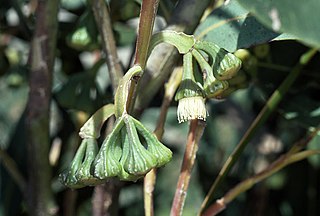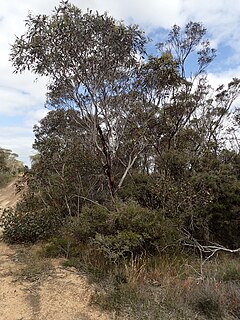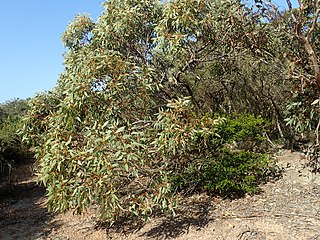Eucalyptus zopherophloia, commonly known as the blackbutt mallee, is a species of spreading mallee that is endemic to an area on the west coast of Western Australia. It has rough bark over part or all of the trunk, smooth grey bark above, narrow lance-shaped leaves, flower buds in groups of nine or eleven, creamy white flowers and conical fruit.

Eucalyptus pyriformis, commonly known as pear-fruited mallee or Dowerin rose, is a species of low, straggly mallee that is endemic to Western Australia. It has smooth greyish brown bark sometimes with ribbony bark near the base, egg-shaped to lance-shaped adult leaves, flower buds in groups of three, red, pinkish or creamy white flowers and down-turned, conical fruit with prominent ribs.

Eucalyptus acies, commonly known as the Woolbernup mallee is a straggly shrub that is endemic to a restricted part of the south-west of Western Australia. It has smooth bark, lance-shaped leaves, club-shaped flower buds with prominent ridges on their sides, creamy white flowers and hemispherical to bell-shaped fruit.

Eucalyptus × balanites, commonly known as Cadda Road mallee, is a tree or a mallee that is endemic to a small area of the south-west of Western Australia. It has rough, corky or flaky bark, lance-shaped adult leaves, flower buds in groups of eleven, creamy-white flowers and hemispherical to cup-shaped fruit.
Eucalyptus famelica is a species of mallee that is endemic to Western Australia. It has smooth grey and pale brown bark, sometimes with thin, rough, fibrous bark near the base of the trunk on larger plants. The adult leaves are lance-shaped, the flower buds are arranged in groups of seven, the flowers are creamy white and the fruit is cup-shaped to cylindrical.

Eucalyptus goniantha, commonly known as Jerdacuttup mallee, is a species of mallee, or rarely a tree, that is endemic to Western Australia. It has smooth bark, lance-shaped adult leaves, flower buds in groups of between seven and eleven, creamy white flowers and more or less ribbed, hemispherical fruit.

Eucalyptus hebetifolia is a species of mallee that is endemic to southern Western Australia. It has smooth grey and brownish bark with loose ribbons of bark near the base, lance-shaped adult leaves, flower buds in groups of up to thirteen, creamy white flowers and conical to barrel-shaped fruit.
Eucalyptus impensa, commonly known as the Eneabba mallee, is a species of straggly mallee that is endemic to a small area of Western Australia. It has smooth bark, dull, light green, egg-shaped to broadly lance-shaped leaves, flower buds arranged singly in leaf axils, pink flowers and relatively large, flattened hemispherical fruit.
Eucalyptus incerata, commonly known as Mount Day mallee, is a species of mallee that is endemic to southern Western Australia. It has smooth bark, lance-shaped adult leaves, flower buds with a long, horn-shaped operculum and arranged in groups of seven, yellow flowers and barrel-shaped to cup-shaped fruit.
Eucalyptus livida, commonly known as wandoo mallee, is a species of mallee or small tree that is endemic to Western Australia. It has smooth bark, lance-shaped adult leaves, flower buds in groups of eleven or more, creamy white flowers and barrel-shaped fruit.
Eucalyptus microschema is a species of small, shrubby mallee that is endemic to the southwest of Western Australia. It has smooth, silvery grey bark, linear adult leaves, flower buds in groups of nine or eleven, white flowers and short, barrel-shaped fruit. It is restricted to a small area near Newdegate.
Eucalyptus obesa, commonly known as the Ninety Mile Tank mallee, is a species of mallee that is endemic to Western Australia. It has smooth, greyish to pale brown bark, usually lance-shaped adult leaves, flower buds in groups of between eleven and fifteen, creamy white flowers and shortened spherical to hemispherical fruit.
Eucalyptus perangusta, commonly known as fine-leaved mallee, is a species of mallee that is endemic to a small area on the south coast of Western Australia. It has smooth bark, glossy green, linear leaves, flower buds in groups of seven or nine, creamy white flowers and short, barrel-shaped fruit.
Eucalyptus quadrans is a species of mallee or a small tree that is endemic to the southwest of Western Australia. It has smooth, greyish bark, narrow lance-shaped adult leaves, flower buds in groups of seven, white flowers and cup-shaped fruit that are square in cross-section.
Eucalyptus tumida is a species of mallee that is endemic to the south coast of Western Australia. It has smooth bark, lance-shaped adult leaves, flower buds in groups of eleven to fifteen, white to pale yellow flowers and cylindrical fruit.

Eucalyptus utilis, commonly known as coastal moort or coastal mort, is a species of mallet or mallee that is native to southern areas of Western Australia. It has smooth bark, egg-shaped to lance-shaped adult leaves, flower buds in group or seven, creamy white flowers and conical fruit.

Corymbia ferriticola, commonly known as the Pilbara ghost gum, is a species of tree or a mallee that is endemic to Western Australia. It has smooth bark, lance-shaped adult leaves, flower buds in groups of seven, creamy white flowers and shortened spherical to cylindrical fruit.

Eucalyptus diminuta, commonly known as the spring mallee, is a species of mallee that is endemic to south-west of Western Australia. It has smooth, silvery to greyish bark, sometimes with rough flaky bark near the base, lance-shaped adult leaves, pendulous, elongated flower buds arranged in groups of seven, creamy white flowers and cup-shaped to bell-shaped fruit.
Eucalyptus × missilis, commonly known as bullet bush, is a species of mallee that is endemic to a small area on the south coast of Western Australia. It has smooth bark, egg-shaped to lance-shaped adult leaves, flower buds in groups of between seven and fifteen, pale yellow flowers and cup-shaped to cylindrical fruit. It is thought to be a hybrid between E. cornuta and E. angulosa that occur in the same area.

Eucalyptus notactites, commonly known as southern limestone mallee, is a species of mallee that is endemic to the southwest of Western Australia. It has smooth, greyish bark, lance-shaped adult leaves, flower buds in groups of between eleven and fifteen, creamy white flowers and hemispherical fruit.











